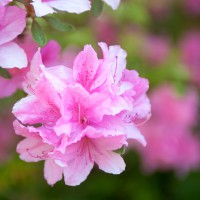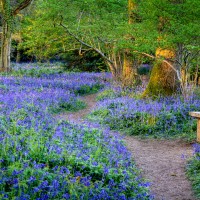Pink is a colour that’s often cutesy and kitsch – but not the way the azalea does it. Come spring, this shrub cascades in waves of electrifying magentas, eye-popping fuchsias and startling salmons. And its other guises – among them riotous reds, lovely lilacs and blazing oranges – are pretty spectacular too.
The azalea is native to Asia, Europe and North America and there are two broad categories of azalea – deciduous (pentanthera) azaleas which lose their leaves in the autumn, and evergreen (tsutsuji) azaleas which keep their leaves year round. Buddhist monks in ancient Japan were among the earliest cultivators of azalea varieties, and over the centuries thousands more have been bred by azalea appreciators across the globe.
Legend has it…
In Chinese folklore, blood red azaleas are said to be the result of a tragedy. The story goes that a king was assassinated and turned into a cuckoo. When the cuckoo sang in the spring, blood came from his bill, staining the azaleas rich red.
Notes for Budding Botanists
- The azalea is related to the rhododendron, however one of the ways to identify which is which is to look at the stamens. If there are five to six stamens, it’s an azalea. If there are more, it’s a rhododendron
- Generally the azalea has five petals, however ‘double varieties’ can have up to 30 petals
- The azalea is highly poisonous – its leaves and nectar contain a chemical called andromedotoxin, which is chemically similar to turpentine. Like turpentine, andromedotoxin creates a burning sensation in the mouth, which is a deterrent for animals who are herbivores (as well as young children)
- To receive a bouquet of azaleas in a black vase was once a well-known death threat
GLORIOUS GARDENS
Viewing Dates Most varieties of azalea flower from April to June (spring/summer in the Northern Hemisphere, winter in the Southern Hemisphere), and there are festivals that celebrate the azalea in Japan, Korea and the United States.
Japan
From April to early May each year, the historic Nezu Shrine in Tokyo’s Yanesen suburb hosts an Azalea Festival with more than 3,000 colourful shrubs in bloom. As part of the celebrations, traditional craftsfolk set up stalls and children wear their best kimonos in the chigo gyoretsu parade.
Where to stay: The luxurious Peninsula in Tokyo is unbeatable for families; centrally located, the superb concierge service here is utterly invaluable when planning your adventures in Japan.
Korea
One of the most popular azalea festivals in Korea is the Yeongchwisan Azalea Festival, which usually takes place in April in the Yeongchwisan Mountain near Yeosu, South Jeolla Province. In spring, pink azalea blooms cover the mountain, which is bigger than 140 soccer pitches and the festival features music concerts, traditional Korean music performances, dance contests and samples of local delicacies that use azalea as the main ingredient as well as a Children’s Dream Festival.
Where to Stay: Take a look at the Bellagio in Yeosu, which costs from $250 per night for a Suite sleeping a family of four.
North America
Georgia The world’s largest azalea garden is at Callaway Gardens in Pine Mountain, Georgia. In spring around 20,000 azalea blossoms – native and hybrid – bloom en masse. From the 40-acre Callaway Brothers Azalea Bowl hillside garden where more than 3,000 hybrid azaleas line a zig-zagging network of walking paths to the Overlook Azalea Garden, this really is the world’s most heavenly spot to be an azalea!
Where to Stay: There is a range of accommodation available in Callaway Gardens itself, but we especially like the look of the Callaway Gardens Lodge and Spa where they also host Summer Family Adventure packages.
Oklahoma Famous for its spring azaleas, the 130-acre Honor Heights Park in Muskogee hosts the annual Azalea Festival each April. The park also includes a well marked rose garden, trees, trails, ponds and an arboretum and has a stunning display of Christmas lights from late November through December. Popular spots throughout the park include the Kirschner Fountain and the picture perfect Rose Garden Gazebo. The Butterfly House is home to several different kinds of butterflies native to Oklahoma; butterfly viewing is usually best in the summer months and the Butterfly Papilion includes a gorgeous array of plants and flowers that attract the stunning creatures each year. Other facilities include an amphitheater, tennis courts, swimming pool, paddle boats, water splash pad, picnic areas, playground, ball field and the Five Civilized Tribes Museum, which is located in the southeast corner of the park.
North Carolina When it comes to springtime pageantry, the five day annual North Carolina Azalea Festival in Wilmington has to be top of a traveller’s bucket list. More than 100,000 people gather to watch the Festival Parade, which begins with the traditional arrival of Queen Azalea. Everywhere blooming azaleas offer colorful testimony to the rich heritage of coastal Carolina, while Southern belles and their escorts promenade through lush gardens at the annual garden party. Often selected as one of The Southeast Tourism Society’s annual Top 20 Events, the festival offers more than 50 events ranging from concerts to art shows, a street fair with interactive displays, home and garden tours, a parade, special exhibits and a circus.
Louisiana A sure sign that spring has arrived in Lafayette is the abundance of azaleas in a spectrum of reds, pinks, whites, purples and salmons. The self-guided Lafayette Azalea Trail starts at the Lafayette Visitor Center on Evangeline Thruway and winds its way around 20 miles of Lafayette landmarks, homes and historical points. The roads are lined with azaleas and some of the bushes of gigantic proportions are over 50 years old. In Lafayette, the predominant variety is the Formosa, christened the “General Lafayette,” which blooms in colors of lavender and fuchsia.
Indiana Azalea Path Arboretum and Botanical Garden A privately owned forest, there are now more than 4,000 azaleas that bloom here each year – usually late April or the first two weeks of May.
Photographic Credits: Shutterstock | Calloway Gardens | Korea Tourism Organisation | Japan Tourism, Nezu Shrine | Azalea Path Arboretum | US National Arboretum










